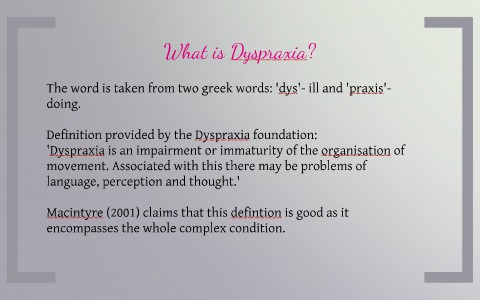Understanding Dyspraxia: A Comprehensive Guide for Parents
Welcome, dear parents! If you’re on a quest to understanding dyspraxia, a condition your child may be experiencing, you’re in the right place! In this guide, we aim to bring clarity and smiles to your face as we shed light on what dyspraxia is, its symptoms, and how it can be managed. Let’s dive in and unwrap the layers of dyspraxia together!
What is Dyspraxia?
Dyspraxia, also known as Developmental Coordination Disorder (DCD), is a common disorder affecting fine and/or gross motor coordination in children and adults. It can also affect speech. It’s a condition that is often present from childhood, and its characteristics can persist into adulthood. Getting to grips with dyspraxia is key to understanding your child and supporting them as they navigate their world.
It’s More Than Just Clumsiness
While many children can be naturally clumsy as they grow, dyspraxia is more than the occasional trip or bump. It’s a condition that involves challenges with movement, coordination, judgment, processing, memory, and other cognitive skills. Yet, with the right approach, parents can provide incredible support and understanding to help their children thrive.
Identifying Symptoms of Dyspraxia
So how can you tell if your child might have dyspraxia? Every child is unique, but there are common signs that might indicate it’s time to consider an evaluation. These can include difficulties with:
- Motor skills: Struggles with tasks like tying shoelaces, buttoning shirts, or using cutlery.
- Coordination: Challenges with sports or activities that require a sense of timing and precision.
- Balance: A tendency to fall, trip, or bump into objects more than peers.
- Spatial awareness: Trouble judging distances, which can make navigating playgrounds or participating in sports challenging.
- Organization: Difficulty in planning activities or maintaining an organized approach to tasks.
- Speech and language: Problems with the flow of speech or the ability to pronounce words correctly.
Spotting these signs early on can lead to a quicker understanding and support for your little one.
The Path to Diagnosis
Diagnosing dyspraxia can be a complex process, as it can often be confused with other learning difficulties or simply dismissed as a delay in reaching developmental milestones. If you suspect your child might have dyspraxia, the first step is usually to talk to your GP or pediatrician. They can refer you to the appropriate specialists, such as occupational therapists or paediatric neurologists, to get a clearer picture.
Exploring everyone’s favorite phrase—”early intervention”—is critical here. Knowing what you’re dealing with sooner rather than later can be a game-changer. It can provide your child with the resources and support they need to navigate daily tasks effectively and boost their confidence.
The Importance of Understanding Dyspraxia
Understanding dyspraxia is the first step in creating a support system for your child. Remember that dyspraxia doesn’t define your child—they are much more than their motor skills. It’s about recognizing their unique challenges and identifying their strengths in order to build a comprehensive support plan that includes not just therapy and medical support, but also love, patience, and understanding.
Building a positive environment where children are encouraged and celebrated for their efforts, regardless of how big or small, inspires them to keep trying and developing skills at their own pace. As a parent, your understanding and advocacy can make all the difference in their progression and self-esteem.
We know that as a parent, you want the absolute best for your child, and that sometimes the world of diagnoses and disorders can feel overwhelming. That’s why we’re here to help make sense of it all, with a sprinkle of joy and a host of helpful tips.
In the upcoming sections of this guide, we’ll explore the various aspects of living with dyspraxia, how to create an enriching home environment, the types of treatments and therapies available, and how to advocate for your child’s needs at school and in other social settings. So stick around, and let’s continue this journey together, one step at a time, celebrating each milestone along the way!
To sum it up, dyspraxia may be a part of your child’s life, but it’s just one piece of the puzzle. With the right support and understanding, your child can absolutely shine in their own unique way. Let’s embrace this adventure with a hopeful heart, shall we?

Five Things Every Parent Preparing for Dyspraxia Should Know
Embarking on the dyspraxia journey with your child comes with challenges, but understanding these key points will help you navigate them more effectively.
-
Early assessment is crucial:
Catching dyspraxia early can significantly improve the outcomes for your child. If you notice any of the symptoms mentioned above, consult with a healthcare professional to assess your child’s needs. Early diagnosis and intervention allow access to therapies and services that can enhance motor skill development and build confidence.
-
Empathy makes a difference:
Living with dyspraxia can be frustrating and challenging for your child. They may feel different from their peers and struggle with tasks that seem simple to others. Approach your child with empathy and patience. Celebrate their successes, no matter how small they may seem, and encourage them through their struggles.
-
Therapies and support vary:
There’s no one-size-fits-all when it comes to managing dyspraxia. Occupational therapy, physical therapy, and speech therapy are common approaches, but each child’s plan will be unique. Collaborate with therapists and teachers to tailor the support to your child’s personal needs.
-
Adapting your home environment:
Creating an organized and structured home can provide a sense of stability for a child with dyspraxia. Keep your home clutter-free and establish clear routines. Tools such as visual schedules or labels can assist in making daily tasks more manageable.
-
Inclusive education is key:
Advocate for your child’s needs within their educational setting. Ensure that they receive the appropriate accommodations to succeed academically and socially. This might include extra time on tests, note-taking assistance, or modifying physical education activities to boost engagement and participation.
Tackling dyspraxia is a team effort that includes family, educators, therapists, and, most importantly, the child. By arming yourself with knowledge and strategies, you can provide your child with a loving and supportive foundation from which they can grow and flourish. Dyspraxia may pose challenges, but with the right support, children with dyspraxia can lead a full and rewarding life. So, keep a positive outlook, and remember that your love and advocacy have a tremendous impact on your child’s success.
Read on to discover more in-depth strategies and inspiring stories on adapting to and embracing life with dyspraxia. Every step you take is a step toward a brighter future for your child, and we’re here to light the path. Hold hands with your little one, and let’s continue this enriching journey of growth and discovery!
See more great Things to Do with Kids in New Zealand here. For more information see here
Disclaimer
The articles available via our website provide general information only and we strongly urge readers to exercise caution and conduct their own thorough research and fact-checking. The information presented should not be taken as absolute truth, and, to the maximum extent permitted by law, we will not be held liable for any inaccuracies or errors in the content. It is essential for individuals to independently verify and validate the information before making any decisions or taking any actions based on the articles.




